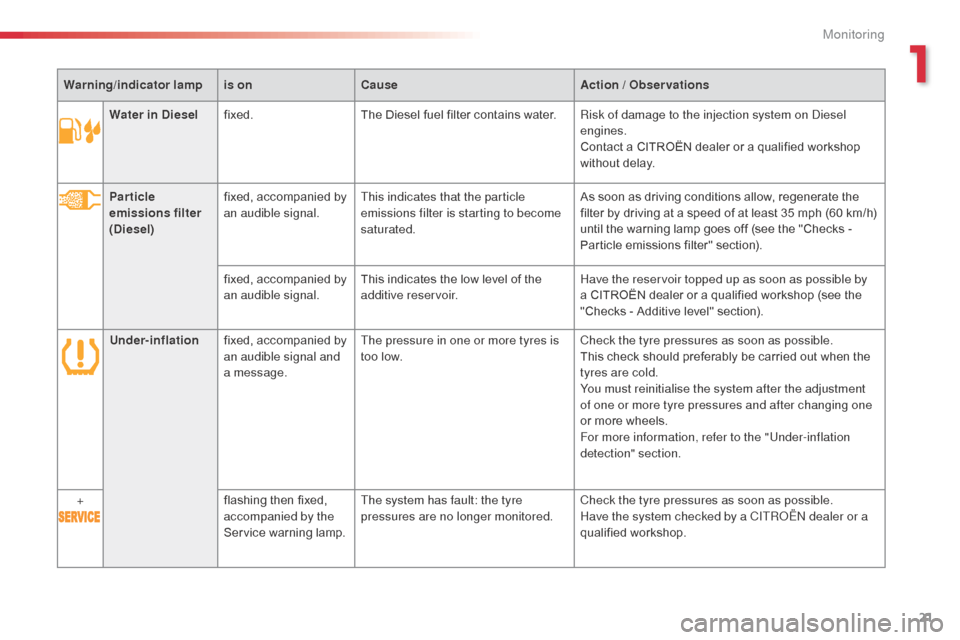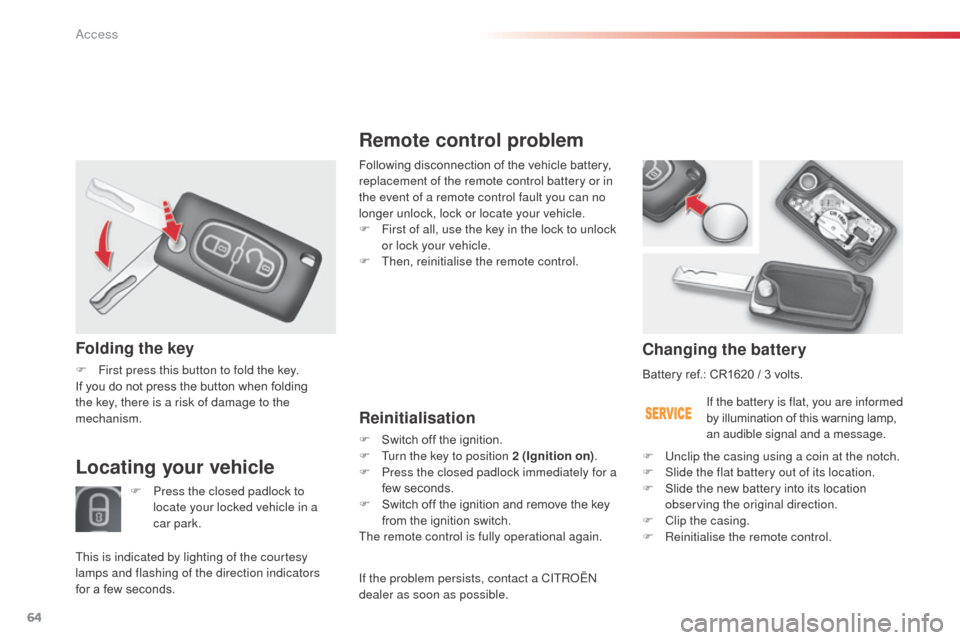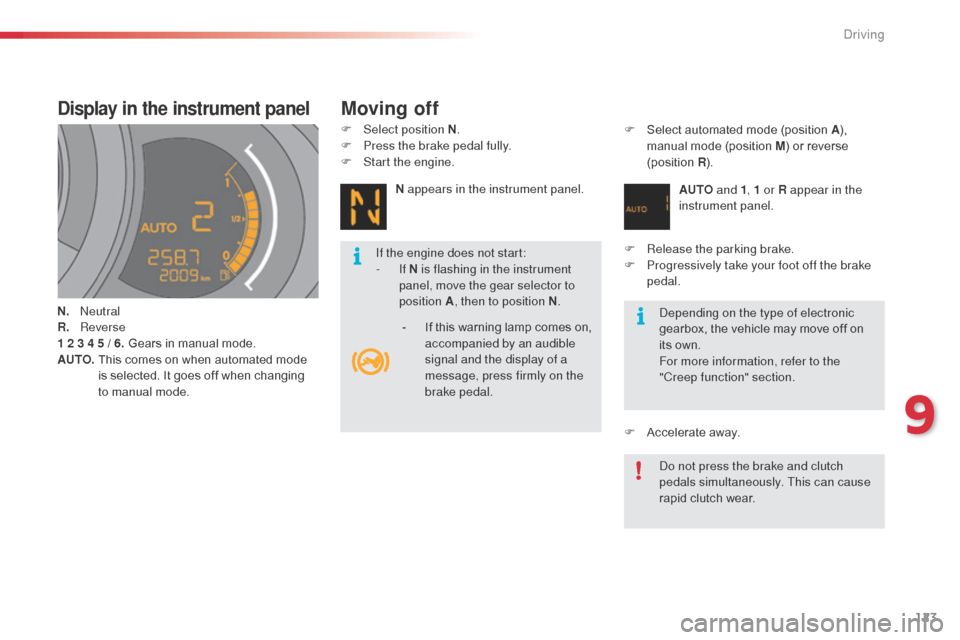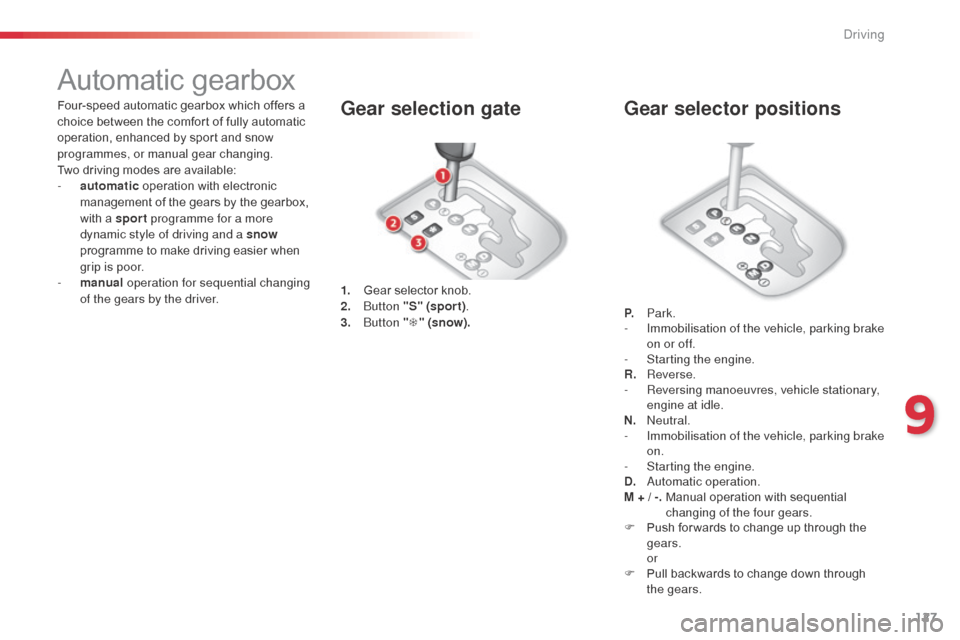changing a Citroen C3 2015 2.G Owner's Manual
[x] Cancel search | Manufacturer: CITROEN, Model Year: 2015, Model line: C3, Model: Citroen C3 2015 2.GPages: 401, PDF Size: 13.04 MB
Page 5 of 401

.
.
Direction indicators 103
Hazard warning lamps 1 03
Horn
10
4
Emergency or assistance call
1
04
Under-inflation detection
1
05
Braking assistance systems
1
09
Trajectory control systems
1
10
Front seat belts
1
11
Airbags
1
13
Safety
Driving recommendations 1 17
Starting-switching off the engine 1 18
Parking brake
1
21
6 -speed manual gearbox
1
21
Electronic gearbox (ETG)
1
22
Automatic gearbox
1
27
Gear shift indicator
1
31
Stop & Start
1
32
Hill start assist
1
35
Speed limiter
1
36
Cruise control
1
38
Rear parking sensors
1
40
Reversing camera
1
42
driving
Emergency or assistance 2 15
7-inch touch screen tablet 2 17
Audio system
2
79
audio and telematics
Alphabetical index
Bonnet 14 4
Petrol engines 1 45
Diesel engines
1
46
Checking levels
1
47
Checks
15
0
Checks
Fuel tank 152
Misfuel prevention (Diesel) 1 54
Running out of fuel (Diesel)
1
55
a
d
blu
e
® additive and SCR system
(BlueHDi Diesel) 1 56
Temporary puncture repair kit
1
66
Changing a wheel
1
71
Changing a bulb
1
78
Changing a fuse
1
85
Changing a wiper blade
1
92
Battery
1
93
Energy economy mode
1
96
Snow chains
1
97
Towing the vehicle
1
98
Towing a trailer
2
00
Practical information Technical data
Petrol engines 2
02
Petrol weights 2 04
LPG engines
2
06
LPG weights
2
07
Diesel engines
2
08
Diesel weights
2
10
Dimensions
2
12
Identification markings
2
13
Visual search
C3_en_Chap00a_sommaire_ed01-2015
Contents
Page 23 of 401

21
Warning/indicator lampis on Cause Action / Observations
Water in Diesel fixed. The Diesel fuel filter contains water. Risk of damage to the injection system on
d
i
esel
engines.
Contact a CITROËN dealer or a qualified workshop
without delay.
Particle
emissions filter
(Diesel) fixed, accompanied by
an audible signal.
This indicates that the particle
emissions filter is starting to become
saturated. As soon as driving conditions allow, regenerate the
filter by driving at a speed of at least 35 mph (60 km/h)
until the warning lamp goes off (see the "Checks
-
Particle emissions filter" section).
fixed, accompanied by
an audible signal. This indicates the low level of the
additive reservoir. Have the reservoir topped up as soon as possible by
a CITROËN dealer or a qualified workshop (see the
"Checks - Additive level" section).
Under-inflation fixed, accompanied by
an audible signal and
a message. The pressure in one or more tyres is
too low.
Check the tyre pressures as soon as possible.
This check should preferably be carried out when the
tyres are cold.
You must reinitialise the system after the adjustment
of one or more tyre pressures and after changing one
or more wheels.
For more information, refer to the "Under-inflation
detection" section.
+ flashing then fixed,
accompanied by the
Service warning lamp.The system has fault: the tyre
pressures are no longer monitored.
Check the tyre pressures as soon as possible.
Have the system checked by a CITR
oËn
dealer or a
qualified workshop.
1
Monitoring
Page 66 of 401

64
Remote control problem
Reinitialisation
F Switch off the ignition.
F T urn the key to position 2 (Ignition on) .
F
P
ress the closed padlock immediately for a
few seconds.
F
S
witch off the ignition and remove the key
from the ignition switch.
The remote control is fully operational again.
Changing the battery
Battery ref.: CR1620 / 3 volts.
If the battery is flat, you are informed
by illumination of this warning lamp,
an audible signal and a message.
F
U
nclip the casing using a coin at the notch.
F
S
lide the flat battery out of its location.
F
S
lide the new battery into its location
observing the original direction.
F
C
lip the casing.
F
R
einitialise the remote control.
Following disconnection of the vehicle battery,
replacement of the remote control battery or in
the event of a remote control fault you can no
longer unlock, lock or locate your vehicle.
F
F
irst of all, use the key in the lock to unlock
or lock your vehicle.
F
T
hen, reinitialise the remote control.
Folding the key
F First press this button to fold the key.
If you do not press the button when folding
the key, there is a risk of damage to the
mechanism.
Locating your vehicle
F Press the closed padlock to
locate your locked vehicle in a
car park.
This is indicated by lighting of the courtesy
lamps and flashing of the direction indicators
for a few seconds. If the problem persists, contact a CITR
oËn
dealer as soon as possible.
Access
Page 89 of 401

87
Boot fittings
1. Rear parcel shelf (
see following page for details)
2.
Hoo
ks
(
see following page for details)
3.
L
ocation for Hi-Fi amplifier
4.
S
towing rings
5.
S
torage box (version equipped with a
temporary puncture repair kit)
(
see following page for details)
or
T
ool box (version equipped with a spare
wheel)
(
refer to the "Changing a wheel" section)
6
Fittings
Page 108 of 401

106
Under-inflation alert
This is given by fixed illumination of
this warning lamp, accompanied by
an audible signal and, depending on
equipment, the display of a message.
F
R
educe speed immediately, avoid
excessive steering movements and sudden
braking
F
S
top the vehicle as soon as it is safe to do
so.
The loss of pressure detected does not
always cause visible bulging of the tyre.
Do not satisfy yourself with just a visual
check. The alert is maintained until the system
is reinitialised.
F
I n the event of a puncture, use the
temporary puncture repair kit or the spare
wheel (depending on equipment),
or
F
i
f you have a compressor, such as the one
in the temporary puncture repair kit, check
the pressures of the four tyres when cold,
or
F
i
f it is not possible to make this check
immediately, drive carefully at reduced
speed.
Reinitialisation
It is necessary to reinitialise the system every
time one or more tyre pressure is adjusted, and
after changing one or more wheels.
a
label attached to the middle pillar, driver's
side, gives a reminder of this.
be
fore reinitialising the system, ensure
that the pressures of the four tyres are
correct for the use of the vehicle and in
line with the recommendations on the
tyre pressure label.
The under-inflation detection system
does not give a warning if a pressure is
incorrect at the time of reinitialisation.
Safety
Page 124 of 401

122
Electronic gearbox (ETG)
R. Reverse
F W ith your foot on the brake, move the
selector for wards to select this position.
N.
n
e
utral.
F
W
ith your foot on the brake, select this
position to start the engine.
A.
a
u
tomated mode.
F
M
ove the selector backwards to select this
mode.
M + / -.
M
anual mode with sequential gear
changing.
F
M
ove the selector backwards, then to the
left to select this mode, then:
-
p
ush for wards to change up a gear,
-
o
r push backwards to change down a gear.
Gear selector positions
+. Paddle to the right of the steering wheel for changing up.
F
P
ress the back of the steering
mounted
"+"
paddle to change up a gear.
-.
P
addle to the left of the steering wheel for
changing down.
F
P
ress the back of the steering
mounted
"-
"
paddle to change down a gear.
Steering mounted controlsFive or six-speed electronically controlled
gearbox which offers a choice between the
comfort of automated operation or the pleasure
of manual gear changing.
Two driving modes are offered:
-
a
utomated mode for automatic control
of the gears by the gearbox, without any
action by the driver,
-
m
anual mode for the sequential changing
of the gears by the driver, using the gear
selector or the steering mounted control
paddles.
In automated mode, you can temporarily take
control of gear changes at any time, using the
steering mounted control paddles.
The steering mounted paddles do not
allow neutral to be selected, reverse
gear to be engaged or disengaged, or
the driving mode to be changed.
Driving
Page 125 of 401

123
Display in the instrument panel
N. neutral
R. R everse
1 2 3 4 5 / 6. Gears in manual mode.
AUTO.
T
his comes on when automated mode
is selected. It goes off when changing
to manual mode. F
Sel
ect position N
.
F
P
ress the brake pedal fully.
F
S
tart the engine.
N appears in the instrument panel. F
S
elect automated mode (position A
),
manual mode (position M) or reverse
(position R).
AUTO and 1, 1 or R appear in the
instrument panel.
F
R
elease the parking brake.
F
P
rogressively take your foot off the brake
pedal.
F
A
ccelerate away.de pending on the type of electronic
gearbox, the vehicle may move off on
its own.
For more information, refer to the
"Creep function" section.
do n
ot press the brake and clutch
pedals simultaneously. This can cause
rapid clutch wear.
If the engine does not start:
-
If
N is flashing in the instrument
panel, move the gear selector to
position A , then to position N .
Moving off
- If this warning lamp comes on,
accompanied by an audible
signal and the display of a
message, press firmly on the
brake pedal.
9
Driving
Page 126 of 401

124
Automated mode
AUTO and the gear engaged appear
in the instrument panel.
The gearbox then operates in auto-adaptive
mode, without any action on the part of the
driver. It continuously selects the most suitable
gear taking account of:
-
o
ptimisation of fuel consumption,
-
d
riving style,
-
r
oad conditions,
-
v
ehicle load.
For optimum acceleration, when overtaking
another vehicle for example, press the
accelerator pedal fully down, beyond the point
of resistance.
Temporary control of gear
changing
You can temporarily take over control of gear
changes using the steering mounted "+" and
"-"
control paddles: if the engine speed allows, the
gear change is carried out.
This function allows you to anticipate certain
situations such as overtaking another vehicle or
approaching a bend.
After a few moments without any action on the
paddles, the gearbox resumes control of gear
changing automatically.
Creep function
(depending on equipment)
This function allows the vehicle to be
manoeuvred more easily at low speeds (when
parking, in traffic jams...).
With the gear selector in position A , M or R,
the vehicle moves as soon as you take your
foot off the brake pedal , at low speed and
with the engine at idle.
do n
ot leave children unsupervised
inside the vehicle when the engine is
running.
You can change mode at any time by
moving the gear selector from A to M or
the other way round.
The creep function may be temporarily
unavailable if the clutch temperature is
too high or the slope too steep.
Never select neutral (position N) when
moving.
F
Sel
ect position A
.
Driving
Page 128 of 401

126
In exceptional circumstances, the
gearbox may need an automatic
reinitialisation: starting and gear
changing are no longer possible.
Operating fault
With the ignition on, if this warning
lamp comes on and AUTO flashes,
accompanied by an audible signal
and a message in the multifunction
screen, this indicates a gearbox
fault.
Have it checked by a CITR
oËn
dealer or a qualified workshop.
Reinitialisation
(5-speed electronic
gearbox)
AUTO and - - appear in the
instrument panel.
F
Sel
ect position N .
F
P
ress the brake pedal.
F
W
ait for around 30 seconds until N or a
gear appears in the instrument panel.
F
M
ove the gear selector to position A , then
to position N .
F
W
ith your foot still on the brake pedal, start
the engine.
The gearbox is operational again. AUTO
and - - appear in the
instrument panel.
Follow the procedure described above.
Following disconnection of the battery, it is
necessary to reinitialise the gearbox.
F
S
witch on the ignition.
driving
Page 129 of 401

127
Automatic gearbox
1. Gear selector knob.
2. bu tton "S" (spor t) .
3.
bu
tton "T " (snow).
Gear selection gate
P. Park.
- I mmobilisation of the vehicle, parking brake
on or off.
-
S
tarting the engine.
R.
Reverse.
-
R
eversing manoeuvres, vehicle stationary,
engine at idle.
N.
n
e
utral.
-
I
mmobilisation of the vehicle, parking brake
on.
-
S
tarting the engine.
D.
a
u
tomatic operation.
M + / -.
M
anual operation with sequential
changing of the four gears.
F
P
ush for wards to change up through the
gears.
or
F
P
ull backwards to change down through
the gears.
Gear selector positionsFour-speed automatic gearbox which offers a
choice between the comfort of fully automatic
operation, enhanced by sport and snow
programmes, or manual gear changing.
Two driving modes are available:
-
a
utomatic operation with electronic
management of the gears by the gearbox,
with a sport programme for a more
dynamic style of driving and a snow
programme to make driving easier when
grip is poor.
-
m
anual operation for sequential changing
of the gears by the driver.
9
Driving